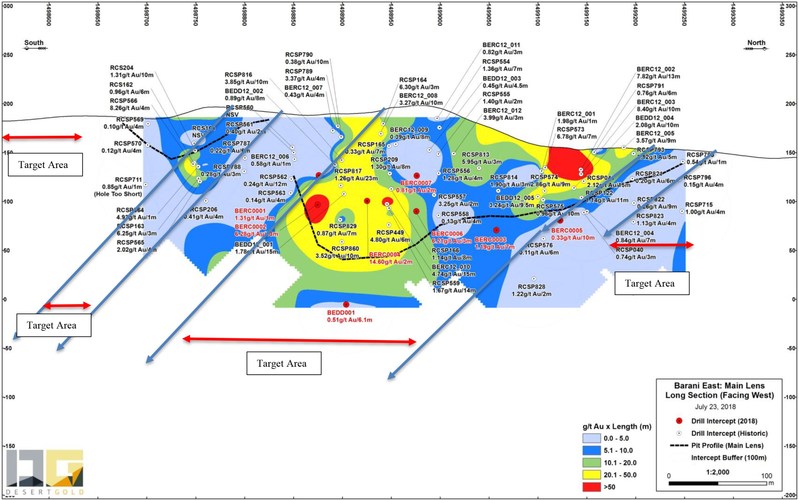Desert Gold Ventures Inc. (TSXV:DAU, OTC:DAUGF, FKFT:QXR2.F) is pleased to announce that it has concluded its previously announced drill program at its Farabantourou Permit in western Mali. This program is a first step of a larger regional-scale gold exploration strategy that is focused along and proximal to the Mali-Senegal Fault Zone (“MSFZ”), which is related to more than 7 multi-million ounce gold deposits1 that are being or have been mined.

This program successfully extended, confirmed and increased our understanding of the gold mineralization at all three target areas with highlights as follows:
- 6.28 g/t gold over 13 metres at Barani East
- 14.6 g/t gold over 2 metres at Barani East
- 6.21 g/t gold over 3 metres at Barani East
- 1.07 g/t gold over 7 metres at Barani East
- 0.85 g/t gold over 14 metres at Barani
- 1.69 g/t gold over 4 metres at Barani
(estimated true widths range from 80 to 95% of drilled width)
Desert Gold’s holds three gold projects (Farabantourou, Segala Ouest and Djimbala) of which Farabantourou and Segala West are located within the Kenieba Inlier of western Mali. The Farabantourou project lies within 40 km to the south of AngloGold Ashanti/Iamgold Sadiola gold mine and 50 km to the north of RandGold Loulo-Gounkoto complex gold mines (see Figure 1).
The Farabantourou exploration program consisted of 30 RC and 1 core hole, together totaling 4,059 meters and property-scale prospecting and geological mapping. Desert Gold targeted three known zones that are related to shear and fracture zones within a folded sequence of mixed limestones, siltstones and shales with stronger gold mineralization related to sulphide replacement zones in altered limestones. This mineralization style mimics that of the nearby sulphide-replacement altered, limestone-hosted Sadiola and Yatela deposits that are host to more than 8 million ounces of gold(1).
| (1) | Randgold’s Loulo-Gounkoto mine complex to the west with ore reserves of 32 Mt average at 4.6 g.t for 3.7 million oz Au in the Proven and Probably category. Endeavour Mining’s Tabakoto and Segala mines which hosts ~3 million oz Au (18.5 Mt at 3.5 g/t for 1.8 million oz Au measured and indicated, 9 Mt at 3.6 g/t for 1 million oz Au inferred and 6.4 Mt at 3.5 g/t for 0.7 million oz Au proven and probable. B2Gold Fekola mine to the south with ore reserves of 48.3 million Mt average at 2.37 g/t gold for 3.34 million oz Au in the Proven and Probably category and 65.8 million Mt average at 2.13 g/t gold for 4.5 million oz Au. To the north Sadiola/Yatela mine contains ore reserves of 38 million Mt at 1.57 g/t gold for 2 million oz Au and 87 million Mt at 1.58 g/t gold for 6 million oz Au in the measured and indicated category. |
The Barani East Zone has returned the best gold grades to date with intercepts to 7.8 g/t gold over 10 metres. The zone consists of at least four, moderate- to steep-east-dipping lenses ranging in width from 4.5 metres to 15 metres along a strike length of approximately 550 metres. As well, there is good potential for parallel zones with intercepts of 2.22 g/t gold over 20 metres that will be followed up. The recent program returned a best intercept of 6.28 g/t gold over 13 metres (see Figure 2). This intercept, along with other drill data supports an open-ended, moderate-southwest-plunging zone that has a 200 metre strike. The recent drilling also suggests that the strike extent of this central, higher-grade portion of the deposit, may be increasing at depth. Additional holes will be planned to test this concept. Several other, potential, southwest plunging sub-zones, which are evident on the long section, will also need to be tested for their down plunge extents. Additional exploration is also planned to test this northeast trending zone, along strike, especially to the southwest where there is substantial laterite cover and an area where the northly-striking Barani and Keniegoulou mineralized structures would intersect the Barani East trend. This intersection area is a high priority exploration target. Due to the extensive laterite cover over the inferred structural intersection target area, an auger program is planned to support drill planning.
The Barani zone has returned drill intercepts of up to 2.19 g/t gold over 9 …read more
From:: Investing News Network

